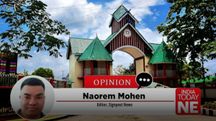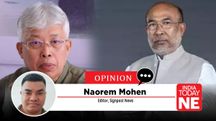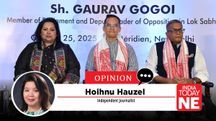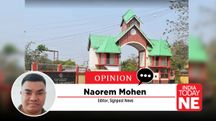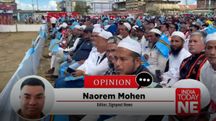If Sangai Skips the Hills, Is It Still Manipur’s Festival
Hosting the 12th Edition of Manipur Sangai Festival 2025 as scaled-down event "for name's sake" is counterproductive; instead, a bold, inclusive approach could generate revenue and foster healing, justifying the investment amid budgetary woes. Critics might be asking, "Is it appropriate to host the festival amid unsolved issues of the state?"
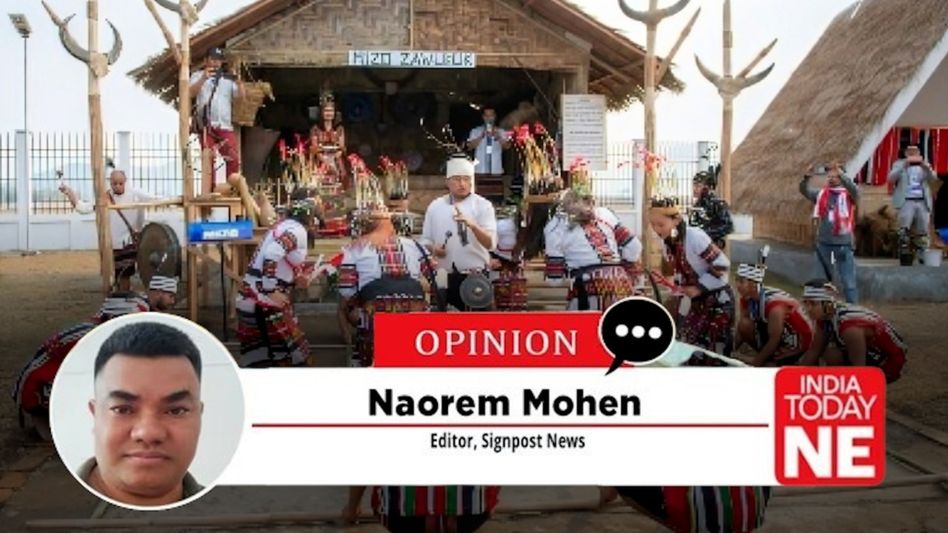
Hosting the 12th Edition of Manipur Sangai Festival 2025 as scaled-down event "for name's sake" is counterproductive; instead, a bold, inclusive approach could generate revenue and foster healing, justifying the investment amid budgetary woes. Critics might be asking, "Is it appropriate to host the festival amid unsolved issues of the state?"
COPMeV—the Committee on Protection of Meetei Victims, representing displaced Meeteis from Moreh, Kangpokpi, and Churachandpur—issued a boycott call on 29 October 2025. The organization has appealed to all the IDPs not to participate in the festival, and urged the Government to cancel it.The committee will not allow the Government to organise the festival.
Their statement was lacerating: “Over 200 dead, thousands homeless, highways strangled, resettlement a mirage—yet the government dances? The deer prances while blood dries?”
As the 12th Manipur Sangai Festival unfolds from November 21–30, 2025—bigger, grander, and more radiant than ever—it stands not merely as an event, but as a resounding declaration of our unbreakable spirit. This festival of oneness is a living tapestry of unity in diversity, where every dance, song, craft, and shared meal reaffirms that Manipur’s strength lies in its mosaic of cultures.
By embracing our resilient IDPs and inviting every community to the table, we transform healing into hope and division into harmony. Let this grand celebration be the turning point—restoring normalcy, reigniting pride, and proving that together, Manipur rises, united, and unbreakable.
Also Read: KSA Flags Recruitment Irregularities at Manipur University; Administration Asserts Compliance with MU Act
The Sangai Festival is not merely an entry on the tourism calendar; it is a living archive of the composite identity of Manipur. Named after the brow-antlered deer (Rucervus eldii eldii), an endangered species found only in the floating phumdis of Loktak Lake, the festival was conceived in 2010 by the state’s Department of Tourism as a deliberate act of cultural diplomacy.
Over ten days each November, it sought to stitch together the valley and the hills, cradle to over thirty tribes across 22,327 square kilometres.In its prime, the festival was a sensory assault and a social experiment. Homestays in remote hamlets overflowed; highways pulsed with convoys of valley day-trippers and hill pilgrims. Attendance peaked at 100,000 in 2019, injecting crores into micro-economies and softening ethnic fault lines through shared meals, bartered crafts, and marathon finish lines.
This was never just revelry. It was resurrection—an annual reminder that Manipur’s geography is not a liability but a lattice. The Sangai on the emblem does not choose sides; it glides from phumdi to ridge. The festival, at its boldest, mirrored that glide.
This state level festival has sprawled across multiple districts, from the bustling streets of Imphal to the serene hills of Churachandpur, Senapati, Ukhrul, and Tamenglong. These venues have allowed diverse communities—be they Meitei, Naga, Kuki, or others—to showcase their arts, crafts, dances, and cuisines, fostering a sense of collective pride.
Yet, as we approach the 12th edition in November 2025, the Manipur government has opted to curtail this expansive spirit, confining the main events primarily to Imphal's Hapta Kangjeibung and Bhagyachandra Open Air Theatre (BOAT). Even the Sangai Ethnic Park in Moirang Khunou, a staple in recent years, has been omitted from the lineup.
On the evening of 3 May 2023, a spark in Churachandpur engulfed the state in ethnic violence. Over 70,000 people became Internally displaced people. Highways walled with the buffer zones. Markets collapse. 910 days later, the scars remain raw. The Imphal–Dimapur, Imphal-Jiribam and Imphal Moreh roads sporadically blockaded, no free movements. Promises of resettlement by December 2025 float without budgets, surveys, or rehabilitation policies. In camps, at least 50 internally displaced persons (IDPs) have died from disease, neglect, or suicide.
The Sangai Festival, scheduled for its 12th edition from 21–30 November 2025, now hangs in this limbo. Organisers face a trilemma: cancel outright, confine to the valley, or dare a statewide rollout under President’s Rule Governance. Each option carries consequences deeper than logistics.
The 2025 edition's pivot to Imphal-centricity, however, signals a regression. Official announcements, including those from high-level meetings chaired by Governor Ajay Kumar Bhalla in September 2025, emphasize a "bigger" festival with enhanced promotion of polo and cultural showcases. Yet, the exclusion of Moirang Khunou's Sangai Ethnic Park—a venue developed specifically for the festival—and the absence of hill district mentions suggest a deliberate contraction.
A compelling counterpoint emerges from the Shirui Lily Festival 2025, held successfully in Ukhrul from May 20-24 despite similar security concerns. Named after Manipur's state flower, the Shirui Lily, this event in a Naga-dominated hill district drew thousands amid the ongoing Meitei-Kuki tensions. Authorities deployed over 2,000 personnel, including BSF and Army units along National Highway 202, conducting regular assessments and strategic placements. Manipur DGP Rajiv Singh personally oversaw arrangements, countering threats from armed groups like Kuki outfits.
Manipur Police statements assured "robust security" for attendees, enabling cultural showcases, conservation talks, and even international visitors. If Ukhrul can host such an event without incident, why can't the Sangai Festival extend to similar areas?
The Shirui Lily festival model demonstrates that with proactive measures—frisking points, drone surveillance, and community dialogues—security is achievable. Applying this to Churachandpur, Senapati, Ukhrul, and Tamenglong for Manipur Sangai Festival would not only be feasible but symbolic: it would signal the government's commitment to normalcy across all terrains, rather than ceding hills to conflict.
If authorities can secure safe passage for Meitei tourists through Kuki villages to celebrate the endangered Shirui Lily during its May bloom in Ukhrul, why not extend similar protections for Kukis, Nagas, and tourists traversing Meitei-dominated valleys to observe the rare Sangai deer in its natural habitat come November?
Reinstating the Churachandpur Public Ground for the Sangai Festival complete with its open-air stage and ethnic cuisine stalls, would signal real commitment. Likewise, unlocking the Mao Gate in Senapati district and where travelers once paused to explore the mystical Willong Sacred Stones is long overdue. And the Sangai Ethnic Park in Moirang Khunou deserves revival, not rusting neglect. These sites weren't mere add-ons; they formed the festival's beating heart, infusing Manipur's tapestry of cultures with shared vitality and drawing global eyes to its ecological wonders.
Any festival without accountability risks salt on wounds.Yet a subtler chorus rises from the margins. In Churachandpur’s non-camp displaced settlements, women who weave ponve on backstrap looms speak not of boycott but of booths. “Give us stalls,” one said anonymously, “and we earn for Christmas gifts.” Another displaced Meitei weaver in an Imphal camp echoed: “My hands are idle; a free space at Sangai could feed my children.” These are not demands for spectacle but for oxygen—economic, psychological, communal. They have been fighting for daily wages.
Picture 21 November 2025. Dawn breaks over Pudunamei as the marathon flag drops; Naga runners in traditional shawls and Meitei athletes in sports kits surge forward, the starting pistol echoing across rhododendron valleys while live feed beams to Imphal’s Kangla. By noon in Churachandpur, Kuki women at free stalls sell handwoven ponve to valley tourists; a Meitei buyer haggles, laughs, buys two. Dusk settles on Ukhrul’s Heritage site, where Tangkhul dancers leap under floodlights and valley children clap in rhythm; a displaced Kuki weaver counts Rs 5000—10,000 enough for Christmas celebration. Night falls in Imphal as Reuben Mashangva fuses Pena with rock; the crowd—valley and hill—roars as one.This is not fantasy.
The Sangai deer does not recognise valley or hill; it runs where the grass is green. Manipur Sangai Festival must do the same. Confine it, and it becomes a postcard—pretty, hollow, divisive. Cancel it, and despair wins. Expand it—with free stalls, fortified convoys, slashed red tape—and it becomes practical medicine: rupees in weavers’ pockets, purpose in youth hands, strangers turned customers carrying threads of resilience home.
The 12th Manipur Sangai festival can be the moment state chooses each other again. The stage is 16 districts wide. The audience is three million strong. The curtain rises on 21 November 2025. Let the deer run free. Let the people follow.
Copyright©2025 Living Media India Limited. For reprint rights: Syndications Today
